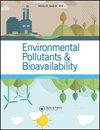Characterization of humic acids derived from Leonardite using a solid-state NMR spectroscopy and effects of humic acids on growth and nutrient uptake of snap bean
Q3 Chemical Engineering
引用次数: 22
Abstract
Abstract Understanding chemistry and the effects of humic substances on plant growth is important for using organic fertilizer or soil amendment for sustainable snap bean production. The objective of this study was to characterize different fractions of humic acid (HA) derived from Leonardite and evaluate their effects on seedling growth and nutrient uptake of snap bean (Phaseolus vulgaris L.). HAs extracted from Leonardite were separated based on molecular weights into three fractions (HS1, HS2, HS3) plus sediment (SED). With direct polarization combined with spectral editing techniques, functional groups of HAs were quantified and the results indicated that HAs with low molecular weights had more O-alkyl and carboxyl C groups than those with large molecular sizes. A plant growth experiment was conducted as a randomized split-plot design with three replications and repeated for three plantings. The results show that addition of HAs was beneficial to leaf and root growth of snap bean compared with the control (no HA). Plants treated with low-molecular weight HAs had significantly greater root length, root surface area, and uptake of potassium by shoot than those treated with other HAs, while leaf growth was affected mainly by HAs with high molecular weight.利用固体核磁共振光谱分析从雷纳迪石中提取的腐殖酸及其对豆荚生长和养分吸收的影响
摘要了解腐殖质的化学性质及其对植物生长的影响,对于利用有机肥或土壤改良剂实现豆角的可持续生产具有重要意义。本研究旨在研究从龙茅属植物中提取的腐植酸(HA)不同组分对菜豆(Phaseolus vulgaris L.)幼苗生长和养分吸收的影响。从莱纳地石中提取的硫化物按分子量分为HS1、HS2、HS3和沉积物(SED)三部分。利用直接极化结合光谱编辑技术,对羟基磷虾酸的官能团进行了定量分析,结果表明,相对于分子量较大的羟基磷虾酸,分子量较小的羟基磷虾酸具有更多的o -烷基和羧基C基团。植物生长试验采用随机分畦设计,3个重复,3个种植重复。结果表明,与不添加HA的对照相比,添加HA对豆荚叶片和根系生长均有促进作用。低分子量HAs处理植株的根长、根表面积和茎部吸钾量均显著高于其他HAs处理,而叶片生长主要受高分子量HAs的影响。
本文章由计算机程序翻译,如有差异,请以英文原文为准。
求助全文
约1分钟内获得全文
求助全文
来源期刊
CiteScore
1.62
自引率
0.00%
发文量
0
审稿时长
1 months
期刊介绍:
Chemical Speciation & Bioavailability ( CS&B) is a scholarly, peer-reviewed forum for insights on the chemical aspects of occurrence, distribution, transport, transformation, transfer, fate, and effects of substances in the environment and biota, and their impacts on the uptake of the substances by living organisms. Substances of interests include both beneficial and toxic ones, especially nutrients, heavy metals, persistent organic pollutants, and emerging contaminants, such as engineered nanomaterials, as well as pharmaceuticals and personal-care products as pollutants. It is the aim of this Journal to develop an international community of experienced colleagues to promote the research, discussion, review, and spread of information on chemical speciation and bioavailability, which is a topic of interest to researchers in many disciplines, including environmental, chemical, biological, food, medical, toxicology, and health sciences.
Key themes in the scope of the Journal include, but are not limited to, the following “6Ms”:
Methods for speciation analysis and the evaluation of bioavailability, especially the development, validation, and application of novel methods and techniques.
Media that sustain the processes of release, distribution, transformation, and transfer of chemical speciation; of particular interest are emerging contaminants, such as engineered nanomaterials, pharmaceuticals, and personal-care products.
Mobility of substance species in environment and biota, either spatially or temporally.
Matters that influence the chemical speciation and bioavailability, mainly environmentally relevant conditions.
Mechanisms that govern the transport, transformation, transfer, and fate of chemical speciation in the environment, and the biouptake of substances.
Models for the simulation of chemical speciation and bioavailability, and for the prediction of toxicity.
Chemical Speciation & Bioavailability is a fully open access journal. This means all submitted articles will, if accepted, be available for anyone to read, anywhere, at any time. immediately on publication. There are no charges for submission to this journal.

 求助内容:
求助内容: 应助结果提醒方式:
应助结果提醒方式:


